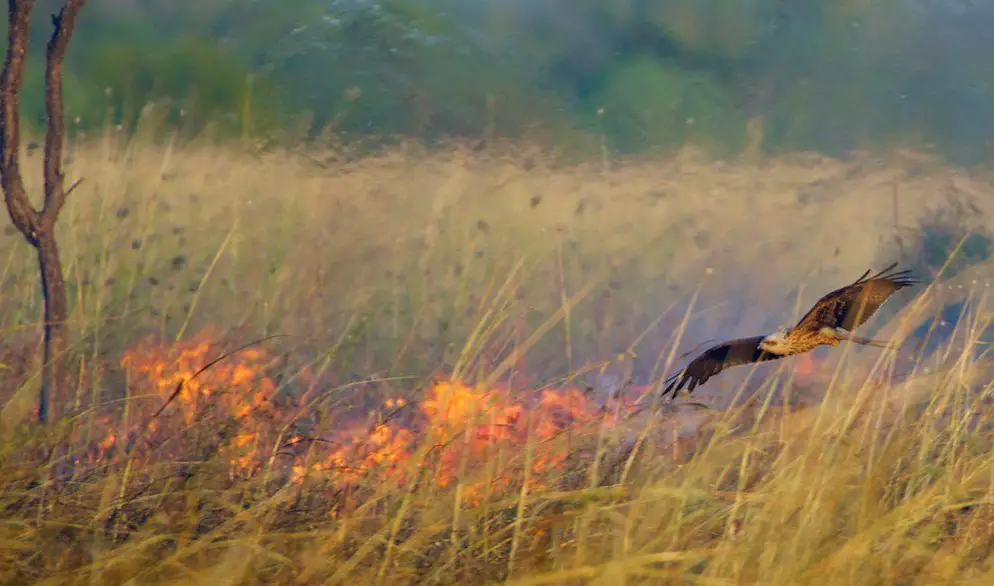Uncategorized
Australian Birds Have Literally Learned How to Weaponize Fire

In Northern Australia, raptors have been found purposefully spreading grass fires, according to a research paper. The purpose is to flesh out prey from the grass and eat.
The Whistling Kite is among the birds alleged to have been doing this, according to a research paper recently published in the Journal of Ethnobiology.
Deep in the rural Australian outback, a veteran firefighter residing in the Northern Territory watched a fire that was stuck on one side of the highway. The fire had no means to jump across the road, but it did. He found the newly lit flames and extinguished them: then he looked up at the sky.
He claims to have seen a whistling kite bird holding a burning twig. The bird flew about 65 feet and dropped the stick into the flammable grass: the fire started again.
Essen’s claims about putting out seven new bird-induced fires were published in the paper.
An author of the paper, Bob Godford told the Australian Broadcasting Corporation:
“Black kites and brown falcons come to these fronts because it is just literally a killing frenzy, it’s a feeding frenzy, because out of these grasslands come small birds, lizards, insects, everything fleeing the front of the fire.”
The concept of birds seeking food or acting as predators in the presence of a fire is actually well established. On at least 4 continents, raptors have been observed waiting for rodents and small animals to flee the scene of a fire to prey upon them, or consume them once they are burned.
However, the idea that the birds might be intentionally setting the fires is definitely new.
The paper’s author is a lawyer who decided to become an ethno-ornithologist, a person who studies the relationship between Australia’s Aboriginal people and birds. He has been chasing the “arson hawk” story for several years.
“My interest was first piqued by a report in a book published in 1964 by an Aboriginal man called Phillip Roberts in the Roper River area in the Northern Territory, that gave an account of a thing that he’d seen in the bush, a bird picking up a stick from a fire front and carrying it and dropping it on to unburnt grass,” he said.
According to the National Post:
“Working with Marc Bonta, an American academic, Gosford searched the historical record for other reports of fire-spreading raptors in Australia. He solicited first-hand accounts of the behaviour online, then personally interviewed those who claimed to have witnessed it.
What Bonta and Gosford found was that the idea of fire-spreading was well known and accepted among residents, and particularly aboriginals, of rural northern Australia. The researchers found first-hand reports of fire-spreading among 12 separate aboriginal groups, while three different species of raptor— the black kite, whistling kite and brown falcon — were definitively identified as fire spreaders.”
Their paper reports 6 brand new firsthand accounts of birds purposefully spreading fire.
A person given the name “MJ,” a cattle station caretaker manager of Kimberley, Western Australia saw kite birds working in cooperation to spread a dry season fire across a river by picking up and carrying little flaming sticks in brittle grass, which immediately ignited in various spots. They wrote: “The experience resulted in an uncontrollable blaze that destroyed part of the station’s infrastructure.”
A firefighter in the Northern Territory named Bob witnessed a small clique of raptors (probably black kites), “pick up numerous smouldering sticks and transport them ahead of a fire front, successfully helping the blaze spread up a small valley.”
A man named Nathan Ferguson says he observed fire spreading birds roughly a dozen times in the Northern Territory, for the past 17 years. The OG fireman adamantly claims that the birds he watched picked up burning sticks and spread the fires with obvious intent. “Most accounts and traditions unequivocally indicate intentionally on the part of three raptor species,” the paper continued.
A definitive video or photographic account of birds doing this has not been produced yet, but it sounds like it will be very soon if this case gets more attention.
It seems quite convincing and real that a bird would have the intelligence to do that: animals are not as dumb as people make them out to be, and our very own technological advancement as human beings might affect the animals around us. We might see animals develop new ways of doing things in our lifetimes.
Image credit: National Post
Typos, corrections and/or news tips? Email us at Contact@TheMindUnleashed.com
